This review covers military events that took place on the territory of Belarus in July 2023. The information is provided as of August 1, 2023.
In July, the general activity of the Belarusian Armed Forces didn’t change significantly. The main efforts were still focused on maintaining the readiness of individual elements of national security. No major military drills were recorded. The main change was the joint training with mercenaries of PMC Wagner.
The Russian component of the joint regional group of troops has been almost completely withdrawn from the territory of Belarus. According to our estimates, about 500 servicemen of the Russian Armed Forces included in the regional group of troops may be stationed at the training grounds and airfields of the Belarusian Armed Forces. This decision may be explained by the fact that the Russian Armed Forces currently have no need to use the infrastructure of the training grounds of the Belarusian Armed Forces. There may also be about 2000 Russian servicemen on the territory of Belarus, who are not included in the regional group of troops.
The arrival of mercenaries of PMC Wagner was a remarkable event . According to our data, from 3800 to 4000 mercenaries could have arrived in Belarus in July. Currently, they don’t take practical aggressive actions against the countries neighboring Belarus. At the same time, the fact of their presence in Belarus creates new challenges to regional security. The situation is complicated by informational and psychological operations conducted both by Yevgeny Prigozhin’s structures (“troll factory”) and the state media of Belarus, as well as by some actors from Ukraine and Poland.
The general medium-term forecast of the development of the military situation in Belarus remains the same: there is no reason to expect an offensive operation by the Russian Armed Forces from the territory of Belarus. As before, the key destabilizing factors that can change the current military situation in Belarus are the deployment of tactical nuclear weapons and the activities of PMC Wagner.
Key points on paragraph 1.1:
- Intensive combat training of the Belarusian Armed Forces was observed in July.
- There were no reports on combat coordination activities or joint drills of the Belarusian and Russian units included in the regional group of troops.
- Reservists are constantly involved in combat training. In total, at least 353 people were drafted for various training sessions in July. The total number of reservists who took part in military training sessions during the seven months of 2023 is at least 8655 people.
- Mercenaries of PMC Wagner began to play a notable role in combat training, actively conducting training with mechanized and artillery units, as well as units of the Special Operations Forces and internal troops.
The following types of combat training activities were conducted in the Belarusian Armed Forces in July:
Field drills — in the 740th Anti-Aircraft Missile Regiment, the 1st Anti-Aircraft Missile Regiment, the Anti-Aircraft Missile and Artillery Divizion of the 120th Mechanized Brigade, reconnaissance units of the North-Western Operational Command of the Belarusian Armed Forces.
Training sessions — in the 51st Artillery Brigade (on the use of software for reconnaissance, control and adjustment of artillery fire), with company commanders and their deputies of the Special Operations Forces units, with battalion and divizion commanders of the Western Operational Command (issues of interaction of troops with artillery, unmanned aerial vehicles (hereinafter — UAVs) and engineering units, installation of mine and explosive barriers).
Tactical-special training — in the 103rd Airborne Brigade (with training in conducting combat in the forest), the 38th Air Assault Brigade (with training on the correct procedure for occupying and equipping a staging area).
Coordination of squads and platoons — in the 6th Mechanized Brigade (with practice in blocking and destroying sabotage and reconnaissance groups).
Company tactical drills — in the 103rd Airborne Brigade.
We can also note other combat training activities:
1) From July 18 to July 20, command-staff drills with units of the 8th Radio Technical Brigade were held near Kletsk. The brigade’s units redeployed to a new position area, where they deployed a mobile command post, built up a radar field, and began to carry out combat duty tasks. The training took place in a situation of active confrontation with UAVs of the conditional enemy.
2) Scheduled flights of ultralight aviation were held in the 5th Special Purpose Brigade. Two types of aircraft were used: the Antares motorized glider and the Yastreb autogyro. Instructors and pilots are currently being trained.
3) Fire control training was held at the Losvida training ground with commanders of paratroop companies (battalions) of the 103rd Airborne Brigade.
4) A comprehensive training was held with servicemen of the 6th Mechanized Brigade on preparation and fire control in a defensive battle.
5) From July 10 to July 14, special operational drills of the Signal Troops were held. During the drills, new forms and methods of organizing communications and the combat use of command and control communications units were tested, taking into account the experience of modern armed conflicts. One of the specifics of the drills was the practice of tasks in both field and urban conditions.
A separate direction of combat training was the training of units of the Belarusian Armed Forces by mercenaries of PMC Wagner. It is known about conducting training with the mercenaries in:
1) The 51st Artillery Brigade — on tactical and firearms training, tactical medicine, artillery fire control. During the training, they practiced various variants of the use of modern means of reconnaissance, control and fire adjustment using UAVs, closed satellite communications, and the Internet.
2) The 38th Air Assault Brigade — four days of tactical special training. The training focused on the organization of interaction between different types of troops during fire attacks, the use of UAVs, tactical methods of movement on the battlefield, and the psychological training of servicemen.
3) The 358th Mechanized Battalion of the 120th Mechanized Brigade — training on squad (platoon, company) coordination.
It was also reported that the mercenaries of PMC Wagner conducted training with engineering units, radiation, chemical and biological defense units, as well as signal units. The details of these trainings are unknown. The mercenaries also conducted training of units of the territorial troops of the Salihorsk district (see paragraph 1.3.3 of Chapter 1).
It should be noted that there were no reports about joint combat training activities of Belarusian and Russian units included in the regional group of troops in July. Moreover, there are good reasons to believe that the main units of the Russian component of the regional group of troops were withdrawn from the territory of Belarus (see paragraph 2.1.1 of Chapter 2). All this confirms the initial conclusion that the regional group of troops was deployed solely to organize the training of Russian mobilized soldiers.
A key specific feature of the organization of combat training of security forces (primarily the internal troops) was joint training with the mercenaries of PMC Wagner. It was reported that the Minister of Internal Affairs, Ivan Kubrakov, and the commander of the internal troops, Nikolai Karpenkov, met with the mercenaries of PMC Wagner. After these meetings, the mercenaries and servicemen of the internal troops began joint training. The training was conducted in the following areas:
- use of UAVs and FPV drones;
- tactical medicine (including application of MARCH PAWS protocols);
- control and interaction with attached fire units;
- organization of communications at control points, etc.
Active training sessions with reservists of the Belarusian Armed Forces and internal troops continued in July.
It was reported about training sessions with reservists of the Belarusian Armed Forces in the 7th Engineering Regiment, the 619th base for storage, repair, modernization and utilization of communications equipment, the 72nd joint training center (at least 20 persons liable for military service; hereinafter — the 72nd training center), the 188th Engineering Brigade (at least 20 persons liable for military service), the 127th Signal Brigade (at least 8 persons liable for military service), and units of the 11th Mechanized Brigade (the 841st Artillery Group, the Anti-Aircraft Missile and Artillery Divizion, and the Material Support Battalion — in total, at least 80 persons liable for military service). The exact number of reservists participating in these training sessions is unknown.
It was reported that military commissariats of the Barysau and Krupki districts, Kruhlaye district, Savetski district of Minsk, Homiel district and Biaroza district, Brest region sent reservists (at least 125 people in total) to military training sessions. According to the clarified information, 24 reservists were drafted to the training sessions in the 19th Mechanized Brigade in June.
We should note the 10-day training session of the assigned personnel of units of the 4th Separate Special Militia Brigade of the internal troops (military units 7404, 5522 and 5526 — deployed in Baranavichy, Hrodna and Brest). More than 100 reservists, who had previously served in the structures of the Ministry of Internal Affairs and the Belarusian Armed Forces, were drafted to the training session. Firearms, tactical, medical and engineering training was conducted at the training center of the internal troops with a team of experienced instructors. The training session ended with tactical special drills. During the drills, they worked out the issues of repelling an attack by an illegal armed group on a settlement, as well as organizing an ambush.
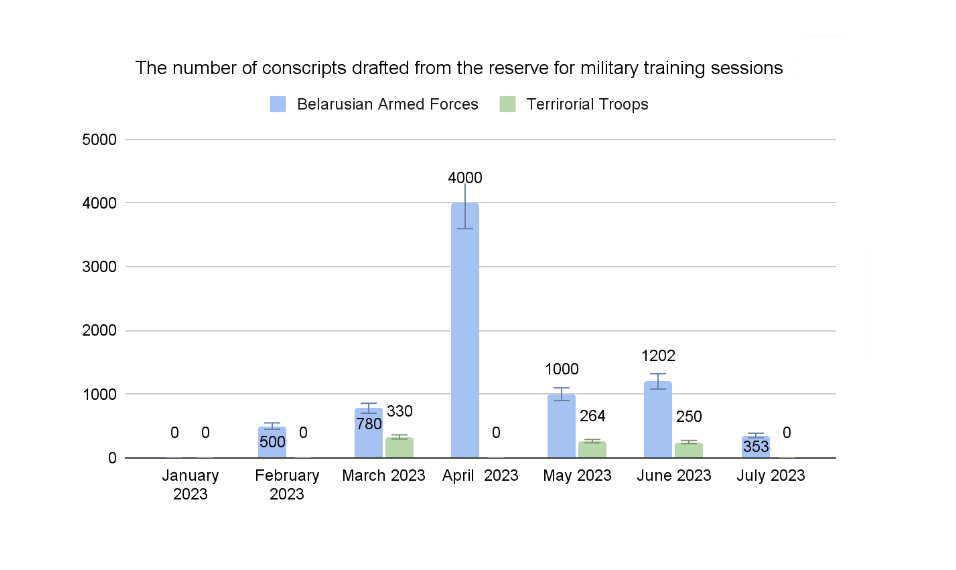
Thus, the total number of reservists drafted to training sessions in July can be estimated to be at least 353 people. In total, at least 8655 people have already been drafted for various types of training sessions from January to July 2023.
We note that this is the lowest number of reservists, since we don’t know about all the military training sessions that have been held. Therefore, in reality, the number of reservists who have passed military training sessions is higher. Earlier, the Ministry of Defense of Belarus reported its plans to draft 9000 people for training sessions in 2023.
Key points on paragraph 1.2:
- The intensity of movements of convoys with equipment of the Belarusian Armed Forces didn’t change compared to June.There was nothing unusual in the movements of military equipment.
- The intensity of movements of the Belarusian Armed Forces by rail increased twofold compared to June. This is connected with field drills and the rotation of units guarding the border with Ukraine.
- No increase in the flight activity of the Belarusian Air Force was recorded.
- The general nature of movements of the Belarusian Armed Forces doesn’t allow us to conclude that troops are being concentrated to commit an act of aggression against Ukraine.
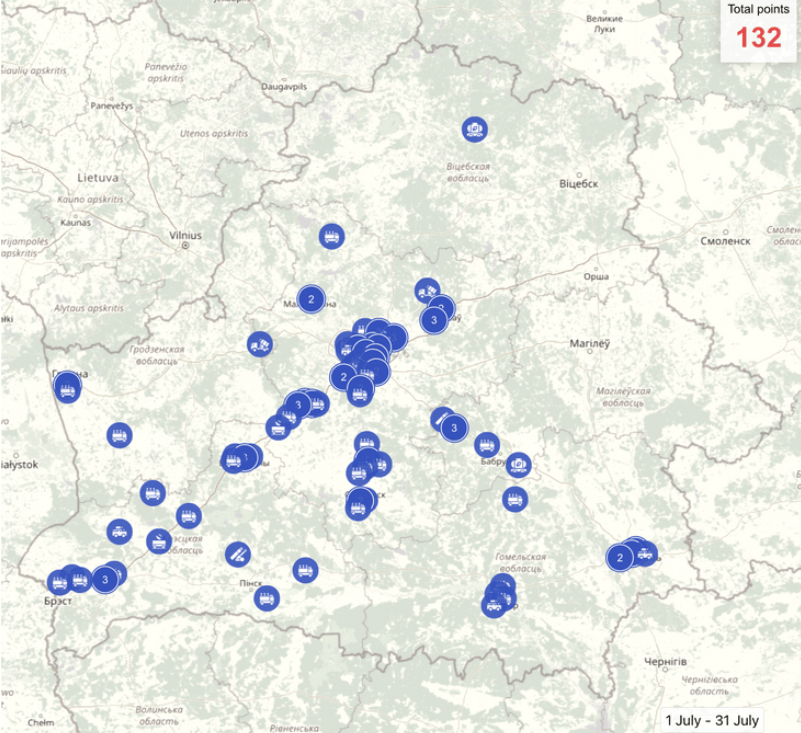
The intensity of movements of both military and combat equipment of the Belarusian Armed Forces didn’t change compared to June.
We can distinguish the following main routes of military equipment’s movements: Minsk-Babruisk, Minsk-Baranavichy, Baranavichy-Brest, Slutsk-Minsk, etc. Military equipment was also recorded in the following towns and cities, where large garrisons of the Belarusian Armed Forces are located: Baranavichy, Minsk, Brest, Barysau, Maladzechna, Mazyr, Hrodna, etc. The highest activity of military equipment’s movements was recorded in Brest region (on the М1 highway and in the vicinity of Baranavichy), Minsk region (on the М1, М3, М5, R23, R53 highways, MKAD, in the vicinity of Minsk and Barysau), as well as in Homiel region (on the M5 highway, in the vicinity of Homiel and Mazyr).
In general, there was nothing unusual in the movements of equipment of the Belarusian Armed Forces. More detailed dynamics of movements of military equipment can be seen on our interactive map.
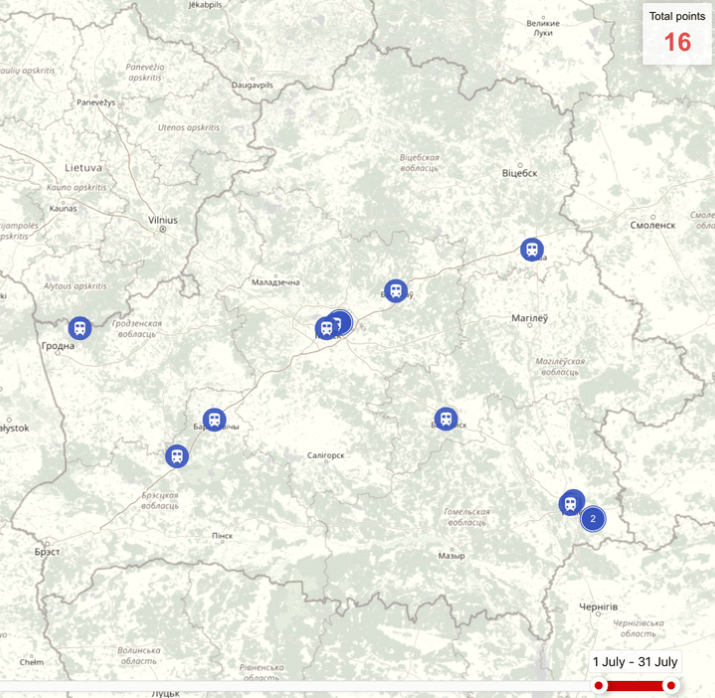
The intensity of movements of the Belarusian Armed Forces by rail increased twofold compared to June. This is connected with the conduct of field drills and the rotation of units that reinforce the protection of the border with Ukraine.
During the month, we recorded movements by rail of units of the 11th Mechanized Brigade, the 147th Anti-Aircraft Missile Regiment, the 740th Anti-Aircraft Missile Regiment, and the Anti-Aircraft Missile and Artillery Divizion of the 120th Mechanized Brigade. These movements are connected with the field drills.
The available information allows us to state that there was another rotation of units of the 103rd Airborne Brigade, which perform tasks to strengthen the protection of the border between Belarus and Ukraine(1, 2, 3). We note that the previous rotation took place in early May of this year. On average, rotations take place once every two months.
The intensity of flights of the Belarusian Air Force remained at the same level compared to June. Lida, Baranavichy, and Machulishchy airfields were mainly used for flights of the Belarusian Air Force. Luniniets, Babruisk, Asautsy airfields and Hrodna airport were also used. During the flights, the entire helicopter and aircraft fleet of the Belarusian Air Force was involved.
It’s notable that the Il-76 military transport aircraft of the Belarusian Air Force with the registration number EW-004DE flew to Tehran, the capital of Iran, for 10 days and stayed there from June 26 to July 6. The purpose of the flight is unknown. In general, it may be connected with military-technical cooperation between Iran and the Lukashenko regime, as well as with the preparation for the visit of Belarus’ Defense Minister Viktor Khrenin to Iran.
Four Su-30SM fighters of the Belarusian Air Force were redeployed from Lida airfield to Baranavichy airfield. The aircraft had been at Lida airfield since May 18, 2023, due to the repair of the runway at Baranavichy airfield.
On July 26, Viktor Gulevich, the head of the General Staff of the Belarusian Armed Forces, visited the 116th assault aviation base. During the visit, he inspected the progress of works to improve the base’s infrastructure (storage facilities for aviation weapons, safety and security systems). Judging by the published photos, Gulevich inspected one of the Granit type storage facilities. Some sources note that earlier such facilities were used to store tactical nuclear weapons. Earlier, it was reported that the Su-25 aircraft in service with the 116th assault aviation base had been reequipped to be capable of using tactical nuclear weapons.
Key points on paragraph 1.3:
- Activities of military commissariats were conducted in normal mode in July.
- Local authorities started the process of creating units of the national home guard.
- Trials of conscripts for evading active military service were recorded.
In July, military commissariats were engaged in military mobilization work. It was reported that training on the procedure for mobilization of vehicles in wartime was held. The military commissariat of the Pruzhany district held an operational meeting with representatives of organizations on the issues of military transport duty. There was also a demonstration of the work of a point of preliminary collection of equipment in Baranavichy and training with the administration of a point of preliminary collection of equipment in Homiel.
It was also reported that at least six demonstration trainings on the procedure for the operation of the notification and collection point for persons liable for military service, as well as on the organization of military registration work in local administration, was held.
Inspections of the organization of the notification of persons liable for military service, the supply of vehicles, and the registration of citizens subject to conscription were conducted.
Active conscription of persons liable for military service into military training sessions continued in July (see paragraph 1.1.3 of Chapter 1).
Among the registration and conscription activities in July, we can note the ongoing conscription of reserve officers for military service. It was also reported that students studying in agricultural educational institutions were drafted for active military service in the reserve.
The results of the spring conscription campaign 2023 were announced. In general, we can state that it won’t be possible to solve the issue of staffing units of the newly formed Southern Operational Command of the Belarusian Armed Forces without increasing the number of conscripts. Despite the reduction of health requirements for conscription, there is a general trend towards a gradual reduction in the number of potential conscripts. As before, the majority of conscripts drafted for active service are distributed among a large number of military units of the Belarusian Armed Forces, which are staffed mainly according to peacetime staff.
In July, there were 3 reported verdicts for evading conscription for active military service. As punishment, conscripts were sentenced to imprisonment (1.5 years), a fine (≈$1175), and community service.

In July, a training session with persons liable for military service of the territorial defense of the Salihorsk district continued. It ended with command-staff drills. Conscripts drafted from the reserve, as well as a detachment of the national home guard, took part in the drills. The training session was also notable as for several days, the reservists were trained by the mercenaries of PMC Wagner.
There were no other reported training sessions with the territorial defense.
It was reported that training with reserve officers of the territorial troops was held in Brest and Kobryn.
Due to the adoption of the Law “On the National home guard”, processes for its formation began. For example, it was reported that a meeting on the procedure for the formation and performance of tasks by the national home guard was held in the Lahoisk district.
Key points on paragraph 1.4:
- No remarkable events in the work of the military-industrial complex were recorded in July.
We can note the following in the work of the Belarusian military-industrial complex in July. Servicemen of the 103rd Airborne Brigade conducted the first stage of tests of a sample of a new Belarusian-made paratrooper backpack. If the first stage is fully completed, the backpacks will be submitted for the next stage of the tests — making a jump with weapons, with a larger load, and from different heights.
Key points on paragraph 1.5:
- The transfer of BM-21 Grad multiple rocket launch systems (hereinafter — MRLS) to the artillery units of the Special Operations Forces of the Belarusian Armed Forces will increase their firepower.
- The vehicle fleet of the Belarusian Armed Forces is being actively renewed.
In July, it was reported that the Belarusian Armed Forces received new samples of military equipment.
The artillery units of the Special Operations Forces of the Belarusian Armed Forces may receive BM-21 Grad MLRS by the end of 2023. This conclusion can be made based on the information about the training of relevant specialists at the 72nd training center.
More than 30 new MAZ-5316 vehicles were handed over to units of the Air Force and Air Defense Forces. Since the beginning of 2023, the Belarusian Armed Forces have received over 100 new MAZ vehicles. By the end of 2023, the Belarusian Armed Forces will receive several hundred more new MAZ-5316 vehicles.
Key points on paragraph 1.6:
- New special-purpose detachments are being formed in the internal troops.
- A new hangar was built for the Iskander missile systems, which were put into service with the 465th Missile Brigade of the Belarusian Armed Forces.
- Work on the construction of the “Khrenin’s Line”, a network of fortified areas to protect Belarus from external military aggression, continues.
As for the military construction, we can mention the formation of special-purpose units on the basis of units of the internal troops. For example, at the beginning of May 2023, four special-purpose detachments were established. These are: Taifun detachment (military unit 5522, Hrodna), Shtorm detachment (military unit 5526, Brest), Buran detachment (military unit 5525, Homiel), and Tsiklon detachment (military unit 7434, Astraviets).
The development of military infrastructure continued. For example, the Federation of American Scientists (FAS) discovered a new hangar for Iskander missile systems in Asipovichy. The hangar is located on the territory of the park of combat vehicles of the military town Yuzhny. The construction of the new hangar may be explained by the start of operation of a fundamentally new model of military equipment for the Belarusian Armed Forces.
Works on the construction of a fortified area continued in the vicinity of Saki village (Zhabinka district, Brest region). According to our information, the construction of a similar fortified area should start soon in the Malaryta district of Brest region.
Key points on paragraph 1.7:
- Belarus and Russia continue formalizing cooperation in the military sphere. Using the example of ratification of the Agreement on the functioning of combat training centers, we can state that legal formalization may lag behind the status quo by several years.
Speaking about the innovations in legislation related to national security, we can note the following:
1) The law “On the National home guard” was signed. The document creates a legal basis for voluntary participation of citizens in ensuring martial law imposed in administrative-territorial units.
2) Belarus ratified the agreement with Russia on the establishment and functioning of combat training centers for joint training of military personnel of the armed forces. The document regulates the establishment and functioning of combat training centers at military units in Belarus and Russia, defines their main tasks and the procedure for interaction between the defense ministries in organizing comprehensive support for these centers.
The decision to establish training centers was made back in March 2021. In Belarus, training centers were established back in August-September 2021: for aviation — at Baranavichy airfield (task: training crews on Su-30SM fighters); for anti-aircraft missile forces — in the 1st Anti-Aircraft Missile Regiment in the Hrodna district (task: training crews to operate S-400 SAM systems). The ratification of the agreement made it possible to legally formalize the already functioning training centers. We note that a representative of the Russian Ministry of Foreign Affairs announced the possible establishment of joint training combat centers for all types and branches of troops.
3) On July 22, Law No. 292-3 “On amending laws” was published on the national legal Internet portal. The document authorizes the All-Belarusian People’s Assembly to approve the military doctrine, impose a state of emergency and martial law, and send servicemen of the Belarusian Armed Forces to other countries.
4) Decree No. 227 “On the dismissal to the reserve and conscription for active military service, service in the reserve” was signed.
Key points on paragraph 1.8:
- No facts of the transfer of military equipment and ammunition by the Lukashenko regime to Russia were recorded in July.
No new reliable facts of the transfer of military equipment, ammunition, and gear to Russia by the Lukashenko regime were recorded in July. This indicates that the equipment and ammunition at the disposal of the Belarusian Armed Forces are limited, and during Russia’s full-scale invasion of Ukraine, these resources could have been partially spent.
Key points on paragraph 1.9:
- At the moment, there is no confirmed information about the transfer of Russian tactical nuclear weapons (hereinafter — TNW) to Belarus.
- There was no new information on the deployment of TNW in Belarus in July.
No new information on the deployment of TNW in Belarus was received in July. There is still no information confirming the transfer of TNW to Belarus.
Among the remarkable events, we can mention the inspection by Viktor Gulevich, the head of the General Staff of the Belarusian Armed Forces, of the 116th assault aviation base. The available information about the visit indicates that it could be related to the possible deployment of TNW on the territory of the base (see paragraph 1.2.3 of Chapter 1).
For more information about possible locations for TNW deployment, see the brief dated April 4, 2023, “Where a tactical nuclear weapons storage may be built in Belarus?”
Key points on paragraph 2.1:
- About 500 servicemen of the Russian Armed Forces included in the regional group of troops may be stationed at training grounds and airfields in Belarus. In total, there may be about 2550 Russian servicemen in Belarus.
- There was a large-scale withdrawal of equipment and personnel of the Russian Armed Forces from Belarus. According to our estimates, at least 10 military cargo trains (260 pieces of equipment, 50 freight cars, and ≈2210 personnel) left Belarus.
- Almost no transfer of equipment and personnel of the Russian Armed Forces to Belarus was recorded.
In early July, intensive movements of the Russian Armed Forces by rail were recorded. We mainly noted the transfer of personnel and military equipment of the Russian Armed Forces from Belarus to Russia. The following military cargo trains with equipment and personnel of the Russian Armed Forces were recorded leaving Belarus:
1) On July 2, a military cargo train of the Russian Armed Forces was being formed at Asipovichy-1 station. It consisted of 62 pieces of equipment (5 Grad MLRS, 30 D-30 howitzers, 2 fuel trucks, 25 trucks) and 3 freight cars.
2) On July 3, a military cargo train of the Russian Armed Forces was being formed at Asipovichy-1 station. It consisted of at least 20 pieces of equipment (3 Grad MLRS, artillery weapons, trucks) and 4 passenger cars.
3) On July 3, a military cargo train of the Russian Armed Forces left Liasnaya station for Kolodeznaya station (Voronezh oblast, Russia). The train consisted of 37 cars and flatcars for the transportation of equipment.
4) On July 3, a military cargo train of the Russian Armed Forces left Palonka station. The train consisted of 27 flatcars for the transportation of equipment (including at least 15 T-80 tanks), 4 passenger cars and 23 freight cars.
5) On July 4, a military cargo train of the Russian Armed Forces was spotted at Orsha station. There were at least 10 pieces of equipment (including 2 mobile reconnaissance units PRP-4 and 1 1V13 vehicle), as well as 1 freight car.
6) On July 5, a military cargo train of the Russian Armed Forces was moving towards Orsha in the Minsk district. The train included at least 40 wheeled vehicles, 11 passenger cars and 6 freight cars.
7) On July 5, a military cargo train of the Russian Armed Forces was spotted at Palonka station. The train consisted of at least 20 empty flatcars, 5 passenger cars, and freight cars.
8) On July 6, a military cargo train of the Russian Armed Forces was moving from Orsha station towards the border with Russia. The train consisted of at least 20 pieces of equipment, 5 passenger cars, and 2 freight cars.
9) On July 7, a military cargo train of the Russian Armed Forces was spotted at Orsha-Centralnaya station. The train consisted of about 20 pieces of equipment, 3 passenger cars, and 3 freight cars.
10) A military cargo train of the Russian Armed Forces was spotted on the Talochyn-Orsha crossing. The train consisted of at least 10 wheeled vehicles, 2 passenger cars, and a number of freight cars.
In total, at least 10 military cargo trains left Belarus: about 260 pieces of equipment, 50 freight cars, and ≈2210 personnel.
We also recorded military cargo trains that arrived in Belarus:
1)On July 3, two freight cars were spotted at Losvida station. Cargo was being reloaded from the cars into a KamAZ truck of the Russian Armed Forces. A REM-KL repair and evacuation vehicle and another KamAZ truck were also spotted at the unloading site.
2) On July 4, a military cargo train of the Russian Armed Forces arrived in Belarus. It consisted of 6 cars.
3) On July 4, a military cargo train of the Russian Armed Forces arrived in Belarus. It consisted of 10 cars.
In total, at least 3 military cargo trains arrived in Belarus. The number of arriving personnel and military equipment is unknown.
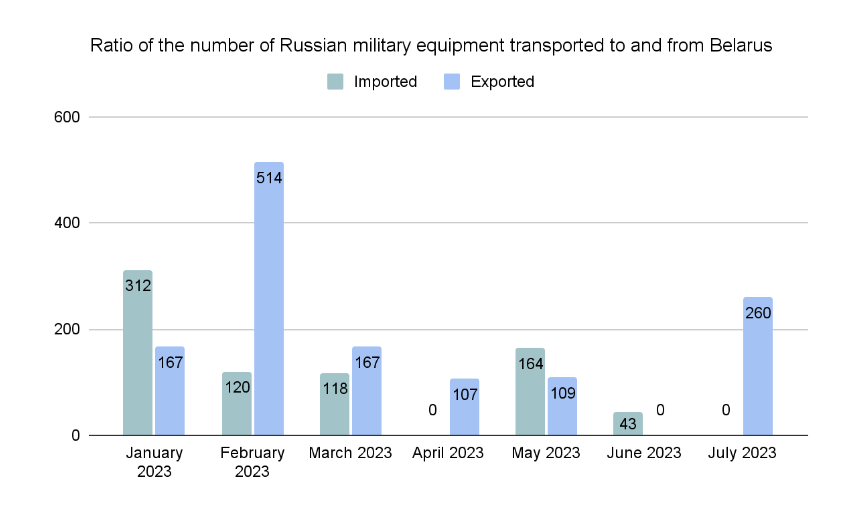
We note that military cargo trains of the Russian Armed Forces mostly left Liasnaya and Palonka stations (Obuz-Liasnouski training ground) and Asipovichy-1 station (Asipovichski training ground). Thus, we may assume that currently the number of the Russian military is the smallest at these training grounds.
We note that the Belarusian Defense Ministry announced a scheduled rotation of the Russian component of the regional group of troops. However, three weeks after this statement, the new units of the Russian Armed Forces haven’t arrived in Belarus. This may indicate that the statement of the Belarusian Defense Ministry about the rotation is an element of an informational and psychological operation.
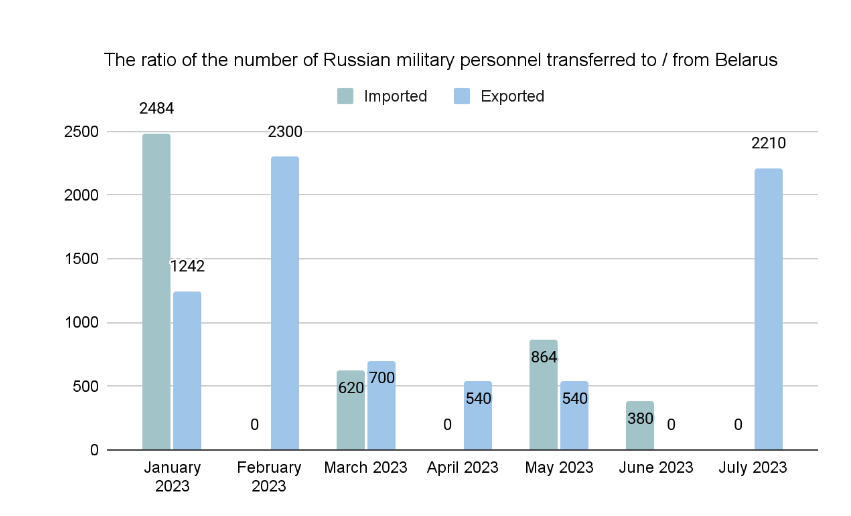
Based on all the mentioned above, we can conclude that there was a significant decrease in the number of Russian troops included in the regional group of troops stationed in Belarus. We may assume that the mass withdrawal of units of the Russian Armed Forces was primarily connected with the fact that the Russian Armed Forces had no acute need for the infrastructure of training grounds, which the Belarusian Armed Forces have. This is also indicated by the fact that the military cargo trains of the Russian Armed Forces were leaving not to the combat zone, but to training grounds located on the territory of Russia.
We note that military cargo trains of the Russian Armed Forces mostly left Liasnaya and Palonka stations (Obuz-Liasnouski training ground) and Asipovichy-1 station (Asipovichski training ground). Thus, we may assume that currently the number of the Russian military is the smallest at these training grounds.
We note that the Belarusian Defense Ministry announced a scheduled rotation of the Russian component of the regional group of troops. However, three weeks after this statement, the new units of the Russian Armed Forces haven’t arrived in Belarus. This may indicate that the statement of the Belarusian Defense Ministry about the rotation is an element of an informational and psychological operation.
As of early June, we estimated the number of Russian military personnel that could have currently been stationed on the territory of Belarus at about 4800 people.
According to satellite images as of the beginning of July, some field camps of the Russian Armed Forces were being dismantled at the training grounds of the Belarusian Armed Forces. For example, as of July 4, the field camps at the Obuz-Liasnouski training ground (work started no later than June 30), Liepielski and Asipovichski training grounds (work started no later than July 2) were almost completely dismantled. The field camps had existed there since October 2022 and were the main places of concentration of the Russian military in Belarus.
The fact that the field camps have been liquidated also confirms our information about the withdrawal of a significant part of the Russian contingent from Belarus. At the same time, we should remember that a small aviation group included in the regional group of troops is concentrated at Machulishchy and Baranavichy airfields (in total, the flight and technical staff may include about 200 people).
Based on the available data (primarily on the movements of the Russian contingent in July, see paragraph 2.1.1 of Chapter 2), we can estimate the number of servicemen of the Russian Armed Forces included in the regional group of troops at about 500 people.
It’s important to note that there are not only Russian military personnel on the territory of Belarus, who are formally part of the regional group of troops, but also Russian servicemen at two military facilities that have been in operation since the mid-1990s. These are the Baranavichy radar station and the Russian Navy’s 43rd communication center in Vileika (the total number of service personnel under the terms of intergovernmental agreements is up to 1450 people). Also, there are Russian military personnel on the territory of Belarus permanently stationed at the airfield in Vialiki Bokau village and Ziabrauka airfield (in total, about 600 people; see paragraph 2.4 of Chapter 2) without any legal status. Formally, the military facilities listed above are not part of the so-called regional group of troops.
Thus, the total number of Russian military personnel stationed in Belarus can be estimated at 2550 people. Of these, from the regional group of troops — 500; stationed at operating and abandoned airfields without legal status — about 600 people; stationed at the Baranavichy radar station and the 43rd communication center — up to 1450 people.
Russian and Belarusian propaganda didn’t report on combat training of the Russian military at the training grounds in Belarus during the month. There were also almost no reports about joint combat training of units of the Russian and Belarusian Armed Forces (see paragraph 1.1.1 of Chapter 1).
The available information on combat training of the Russian military can be found in the review of the main military events in Belarus for April 2023.
Due to the reduction in the number of the Russian contingent permanently stationed in Belarus, there were almost no reports about the activity of the Russian military in the settlements located near the training grounds of the Belarusian Armed Forces during July. During the month, the Russian military were spotted only in Asipovichy and Orsha.
This is primarily connected with the liquidation of field camps of the Russian Armed Forces at the training grounds of the Belarusian Armed Forces, where the Russian military were trained.
Key points on paragraph 2.2:
- The intensity of movements of equipment of the Russian Armed Forces decreased compared to June. There were almost no movements of equipment of the Russian Armed Forces recorded in the areas bordering Ukraine.
- The level of movements of the Russian Armed Forces by rail increased compared to June.
- The intensity of flights of the aviation group of the Russian Aerospace Forces stationed in Belarus decreased.
- In general, the decrease in the intensity of movements of equipment of the Russian Armed Forces and flights of the Russian Aerospace Forces, as well as the increase in the intensity of movements by rail can be connected with the reduction in the number of the Russian contingent, which is permanently stationed in Belarus.
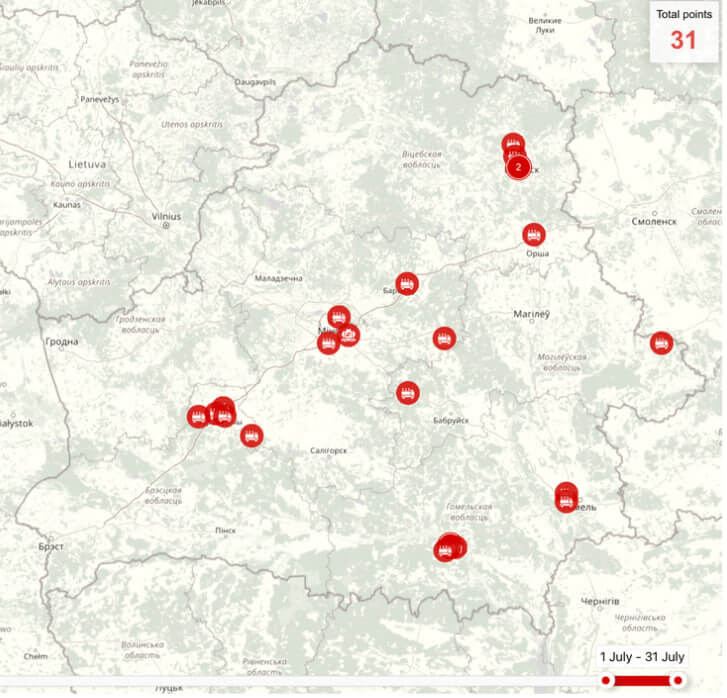
The intensity of movements of both military and combat equipment of the Russian Armed Forces decreased by 35% compared to June. This is primarily connected with the reduction in the number of the Russian component of the regional group of troops in Belarus. The highest activity of movements of military equipment was recorded in Brest region (on the M1 highway, in the vicinity of Baranavichy), Homiel region (near Homiel and Mazyr), in Minsk region (in the vicinity of Minsk), as well as in Vitsiebsk region (in the vicinity of Vitsiebsk). Almost no equipment of the Russian Armed Forces was recorded in the areas of Belarus bordering Ukraine. Military vehicles were also spotted in the following towns and cities: Baranavichy, Homiel, Mazyr, Vitsiebsk, and Minsk.
More detailed dynamics of movements of equipment of the Russian Armed Forces is available on our interactive map.
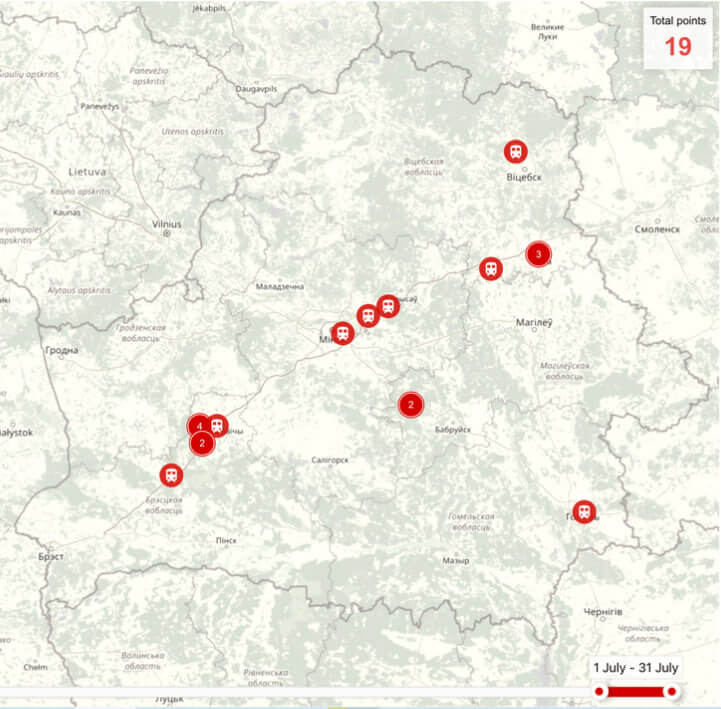
The intensity of movements of the Russian Armed Forces by rail increased more than twofold compared to June. During the month, we detected the arrival of at least 3 small military cargo trains with equipment and personnel of the Russian Armed Forces in Belarus, as well as the departure of 10 military cargo trains to Russia (see paragraph 2.1.1 of Chapter 2). The route via Orsha and further to Smolensk was mainly used for the transfer of troops to Belarus from Russia / to Russia from Belarus.
The nature of movements by rail currently allows us to state that there is a reduction and withdrawal of the forces and means of the Russian Armed Forces from Belarus.
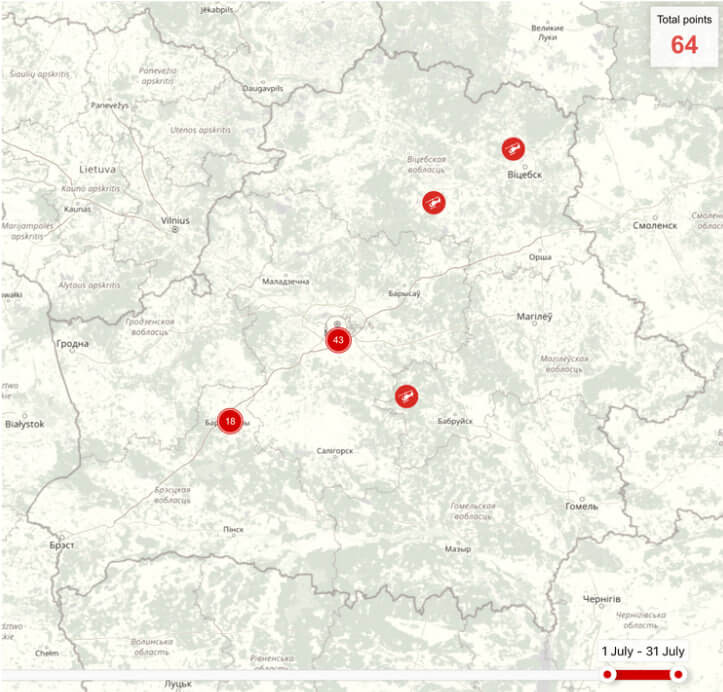
The intensity of flights of the Russian Aerospace Forces in Belarus decreased by almost 30% compared to June. This can be connected with the reduction of the Russian component of the regional group of troops in Belarus.
As of August 1, 2023, the aviation group of the Russian Aerospace Forces in Belarus included:
- fighters and bombers: at least nine Su-34 and Su-30SM (stationed at Baranavichy airfield);
- helicopters and fighters: one fighter of unknown type, 11 Mi-8, Mi-24 and Mi-28 helicopters (stationed at Machulishchy airfield).
During the month, there were changes in the size of the aviation group of the Russian Aerospace Forces in Belarus. On July 25, a fighter of the Russian Aerospace Forces arrived at Machulishchy airfield from Russia. According to our information, it may be the MiG-31 fighter-interceptor. The information requires verification.
Therefore, the aviation group of the Russian Aerospace Forces increased by one fighter in July.
On July 19, at least nine Su-34 and Su-30SM fighters of the Russian Aerospace Forces redeployed from Machulishchy airfield to Baranavichy airfield. The aircraft were temporarily stationed at Machulishchy airfield (from May 18 to July 19) due to the repair of the runway at Baranavichy airfield. In turn, nine helicopters of the Russian Aerospace Forces redeployed from Baranavichy airfield to Machulishchy airfield. These helicopters were also redeployed on May 18 due to the redeployment of fighters of the Russian Aerospace Forces to Machulishchy airfield. The repair of runways at Lida and Machulishchy airfields can be expected in the near future. Earlier, construction materials were purchased for this purpose.
Military transport and passenger aircraft of the Russian Aerospace Forces, as well as aircraft of PMC Wagner, continued to arrive at Belarusian airfields. The aircraft arrived at:
Machulishchy airfield: passenger — 4 flights of business jets associated with Yevgeny Prigozhin (Embraer Legacy 600 reg.number RA-02795 and BAe 125-800B reh.number RA-02878); transport — 1 An-12, 2 An-72, 4 An-26, 3 Il-76.
Baranavichy airfield: passenger — 1 An-148; transport — 1 An-26.
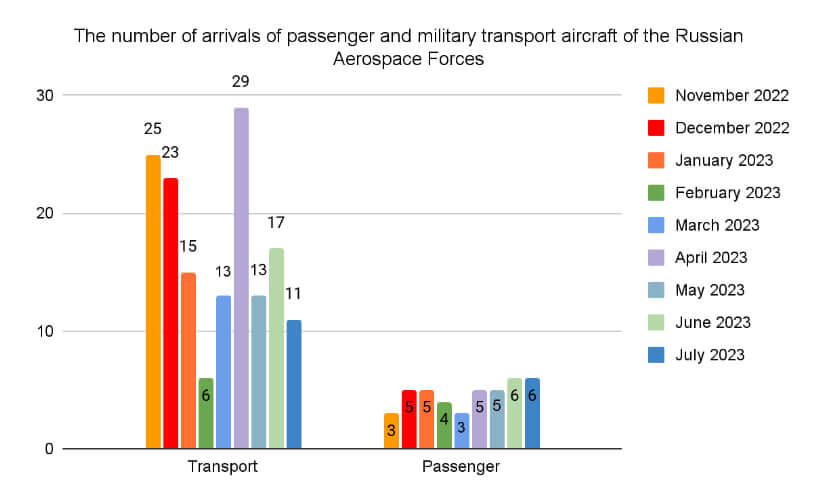
As we can see, the number of arrivals of military transport aircraft decreased in July compared to June, while the number of passenger aircraft remained almost at the same level. At the same time, four out of six arrivals of passenger aircraft were connected with the arrivals of Yevgeny Prigozhin’s planes to Belarus.
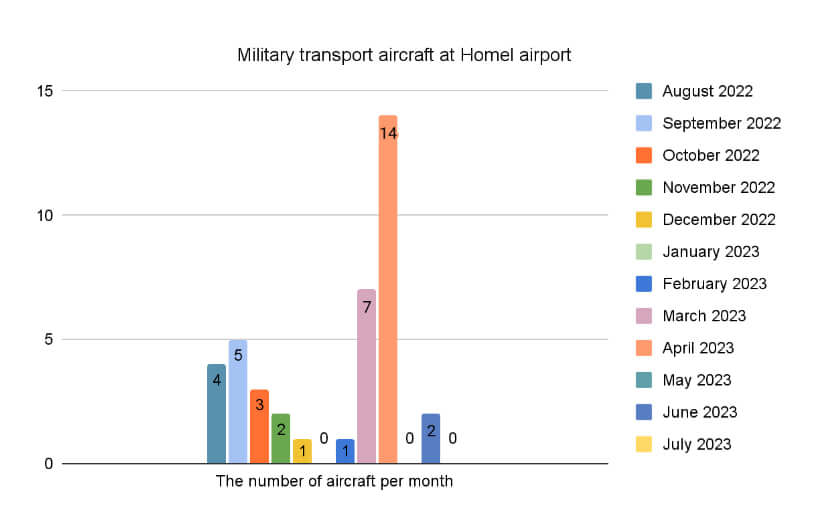
During the month, no activity of the Russian Aerospace Forces was recorded at Homiel airport. We recall that from March 25 to April 18, 25 An-124 military transport aircraft of the Russian Aerospace Forces arrived at the airport. In general, their arrivals could be connected with the activity of the Russian military at Ziabrauka airfield (see paragraph 2.4 of Chapter 2).
Key points on paragraph 2.3:
- The threat of missile strikes from the territory of Belarus by ground-based and air-based systems remains.
- The withdrawal of MiG-31K aircraft from Belarus decreases the ability of the Russian Armed Forces to launch strikes with air-to-surface missiles.
- If necessary, the group of the Russian Aerospace Forces stationed in Belarus, as well as anti-aircraft missile systems, can be used to launch missile strikes.
In July, no missile strikes against Ukraine from the territory of Belarus were recorded. We note that the last missile strike at the territory of Ukraine from the territory of Belarus was launched on October 6, 2022.
The withdrawal of MiG-31K fighter-interceptors capable of using Kinzhal hypersonic missiles from the territory of Belarus in April 2023 reduces the possibility of air-based missile strikes. At the same time, Su-34 bombers and Su-24MR tactical reconnaissance aircraft, as well as Su-30SM fighters, which can be used for missile strikes against the territory of Ukraine if needed, remain at Machulishchy and Lida airfields. We should also remember that S-300/400 SAM systems of the Russian Armed Forces, which can also be used for missile strikes, are stationed at the airfield in Vialiki Bokau and Ziabrauka airfield (see paragraph 2.4 of Chapter 2).
The restriction zone for flights of all types of civil aircraft (including UAVs) at altitudes from 0 to 19,800 meters in the south of Belarus, extended according to NOTAMN O0403/23, is active until October 1, 2023. The ban on flights over the southern part of Belarus was introduced on February 24, 2022.
The facts mentioned above allow us to conclude that there’s a potential threat of missile strikes from the territory of Belarus.
Key points on paragraph 2.4:
- The Russian Armed Forces continue to use their military facilities in the southern regions of Belarus. Currently, there are no signs that this activity will stop.
- Military bases of the Air Defense Forces of the Russian Armed Forces are deployed at the airfield in Vialiki Bokau village (Mazyr district) and at Ziabrauka airfield (Homiel district).
Russian military equipment was repeatedly spotted in Mazyr and its vicinity in July. This is indirect evidence of the presence of the Russian military at the airfield in Vialiki Bokau village, Mazyr district.
According to the satellite images dated May 6, the following was stationed at the airfield:
- 8 launchers of S-300/400 SAM system;
- 1 Pantsir-S1 self-propelled anti-aircraft gun and missile (SPAAGM) system;
- 3 5Т58 transport semi-trailer vehicles of S-300/400 SAM system;
- 1 armored personnel carrier;
- 18 trucks;
- 1 92N6 radar;
- 1 91N6 surveillance and tracking radar;
- 1 76N6 radar on the 40V6M universal mobile tower;
- 1 96L6E all-altitude detector on the 40V6 universal mobile tower;
- 6 pieces of unidentified military equipment;
- 8 mockups of military equipment (6 of them are S-300/400 SAM systems);
- 10 unknown objects under the camouflage net;
- 11 tents (1 USB-56, 1 UST-56, 4 М-10, 5 М-30, the total capacity is about 300 people).
According to satellite images, we can draw preliminary conclusions that construction work continues at Ziabrauka airfield. This may mean the construction of new embankments to deploy elements of the air defense system.
Information about the deployment of military equipment at the airfield is given in the table below.
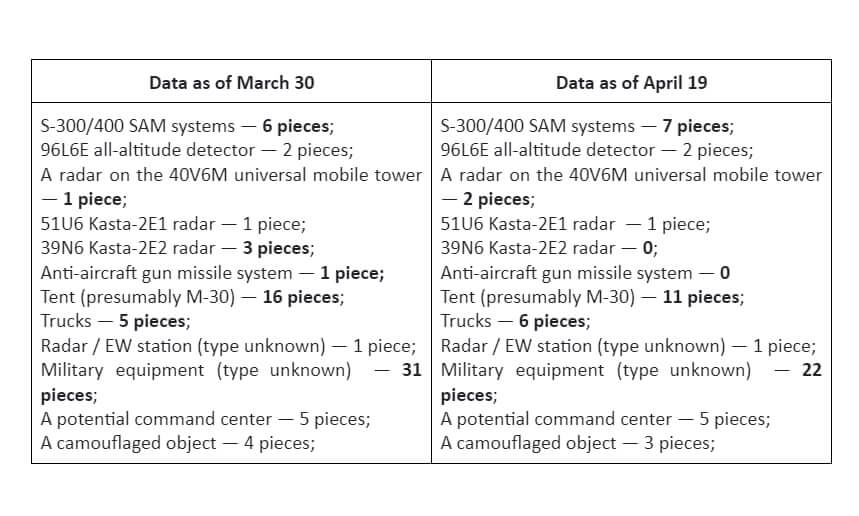
Thus, the airfield is still occupied by the Russian military without any legal status (such as a military base). All this indicates that the Russian Armed Forces are planning to continue operating the airfield in Vialiki Vokau village and Ziabrauka airfield.
Key points on paragraph 2.5:
- A large camp was set up in the Asipovichy district to accommodate mercenaries of PMC Wagner.
- From 3800 to 4000 mercenaries of PMC Wagner could have arrived in Belarus in July.
- The mercenaries are engaged in equipping the places of their deployment, as well as training the Belarusian Armed Forces and the internal troops.
In July, we recorded the arrivals of planes associated with Yevgeny Prigozhin four times: on July 1, July 11, July 18 and July 29. During his arrivals, Prigozhin visited the field camp of mercenaries located in Tsel village, Asipovichy district.
According to information at our disposal, mercenaries of PMC Wagner began an organized movement in convoys to the territory of Belarus on July 11. Currently, we know about at least 13 convoys, with 3800 to 4000 mercenaries and 830-870 vehicles with license plates of the unrecognized DNR and LNR arriving in Belarus. There was also information about the deployment of mercenaries on the territory of the Losvida military training ground. It should be noted that the number of Wagner mercenaries in Belarus already significantly exceeds the needs of the Belarusian Armed Forces in instructors with combat experience.
As reported by a number of propaganda resources, the mercenaries of PMC Wagner should leave the territory of the unrecognized LNR by August 1. In this regard, we should expect the arrival of separate convoys with equipment of the mercenaries in Belarus. We should also note that Shchuka (Chekan) armored vehicles arrived in Belarus as part of the convoys. The mentioned equipment is a distinctive vehicle of PMC Wagner.
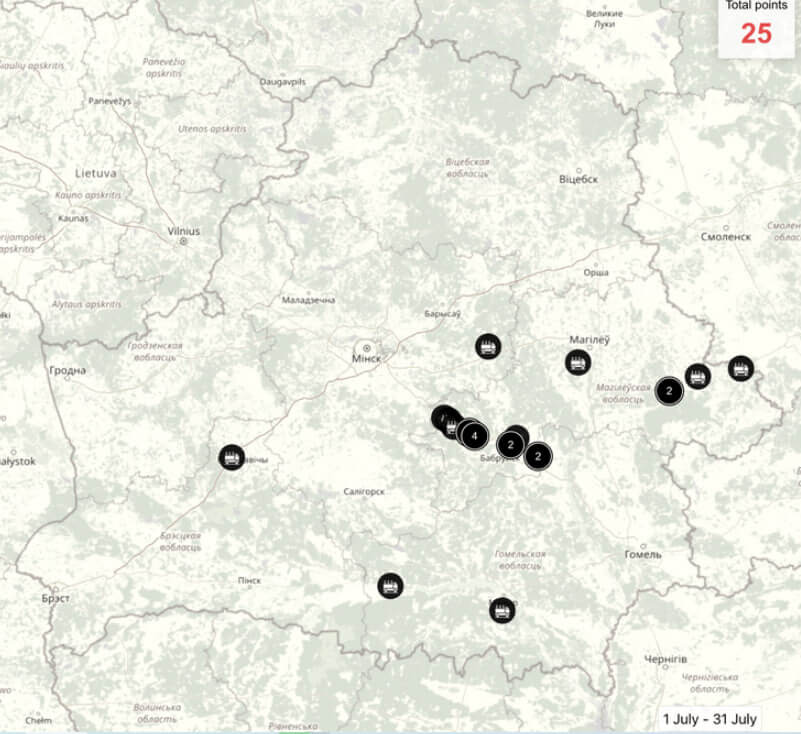
The peak of the organized movement of mercenaries to the territory of Belarus was from July 15 to July 19. The convoys arrived by the following routes:
- Russia-Belarus border — R43 highway (via Cherykau, Dousk, Babruisk) — M5 highway — a field camp in Tsel village.
- Russia-Belarus border — R43 highway (via Krychau, Cherykau) — R122 highway (via Chavusy, Mahiliou) — M8 and R93 highways (Mahiliou — Babruisk) — M5 highway — a field camp in Tsel village.
On July 16, a propaganda Telegram channel published information that mercenaries of PMC Wagner would become an addition to the regional group of troops of Belarus and Russia. Funding would be at the expense of the budget allocated by the Russian Ministry of Defense. We note that this statement wasn’t published on Belarusian or Russian official resources. Also, the Telegram channel that spread this information was earlier repeatedly found to support informational and psychological operations, as well as disinformation campaigns.
The main location of the deployment of Wagner mercenaries in Belarus is a field camp in Tsel village, Asipovichy district. There are also reasons to assume that since mid-July, the mercenaries started using old military storage facilities on the territory of the former military town №28 Paplavy in the Asipovichy district.
Currently, we can state that the mercenaries are engaged in equipping their places of accommodation in Belarus, as well as in conducting combat training with units of the Belarusian Armed Forces and the internal troops.
For more information about the redeployment of PMC Wagner to Belarus, see the brief dated July 15, 2023, “Redeployment of Wagner mercenaries to Belarus: Updated.”
- During the month, the Belarusian Armed Forces functioned as usual. Combat training activities were seasonal and scheduled.
Currently, there is no evidence that the Lukashenko regime is preparing its forces for joint participation with the Russian Armed Forces in combat operations against Ukraine. The Belarusian Armed Forces are still incapable of conducting an offensive operation against Ukraine on their own. There are still no reasons to believe that the Belarusian Armed Forces will be involved in combat operations in Ukraine in the medium term.
- The Russian Armed Forces withdrew the main part of the contingent of the regional group of troops. Currently, a small aviation group of the Russian Aerospace Forces, two military bases of the air defense forces (at the airfields in Vialiki Bokau village and at Ziabrauka airfield), as well as military facilities (the Baranavichy radio-technical center and the 43rd communication center of the Russian Navy in Vileika) are deployed in Belarus.
The withdrawal of the main part of the Russian component of the regional group of troops indicates:
- lack of plans to conduct an offensive operation from the territory of Belarus;
- lack of necessity to train mobilized Russians at the training grounds of the Belarusian Armed Forces.
At the same time, the Russian Armed Forces can again transfer their units to Belarus at any moment. Therefore, the most probable scenario is currently Scenario №3. Belarus is a permanent training base for the Russian military.
Note. Scenario 3. Belarus is a permanent training base for the Russian military. In this scenario, Russian servicemen (mostly mobilized Russians) will arrive at the training grounds in Belarus, pass a course of military training, and leave for the combat zone. New mobilized soldiers will arrive instead. Its implementation is currently indicated by the following:
- Periodic intensification of movements of the Russian military by rail to/from Belarus.
- Lack of redeployment of military equipment of the Russian Armed Forces to the training grounds in Belarus (except the rotation of personnel).
- Regular extension of drills at the training grounds of the Belarusian Armed Forces.
We note that if the Russian Armed Forces do not transfer their units to Belarus for training and combat coordination within the next month, the scenarios and forecasts of the Russian military presence in Belarus will be reconsidered.
- In general, we can state that PMC Wagner adopted from the regional group of troops the task of creating tension with the countries bordering Belarus. It should be noted that this is supported by informational and psychological operations. For example, fake news about the alleged desire of the mercenaries to seize the Suwalki gap, etc. The presence of Wagner mercenaries in Belarus creates new potential security risks for the countries bordering Belarus.
It’s important to note that despite the reduction of the Russian component of the regional group of troops, the number of the military group associated with Russia has increased due to the arrival of mercenaries of PMC Wagner. Thus, the total number of the Russian military and mercenaries of PMC Wagner may be from 6350 to 6550 people. This number is less than it was at the peak of the deployment of the regional group of troops in early 2023, but more than the number of the Russian military in Belarus over the past months.
